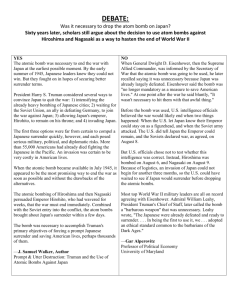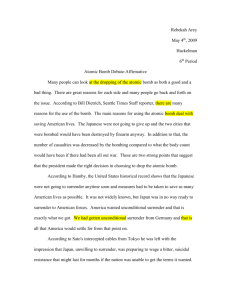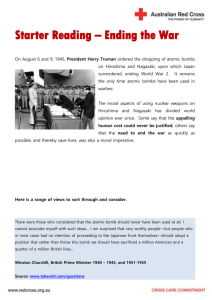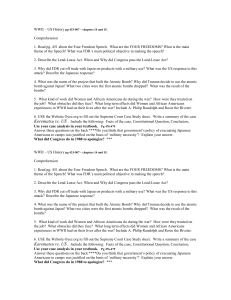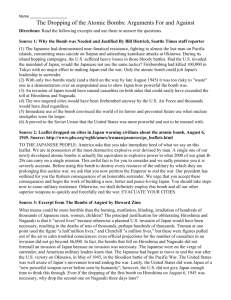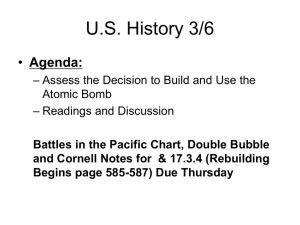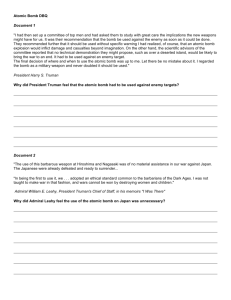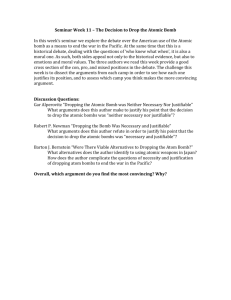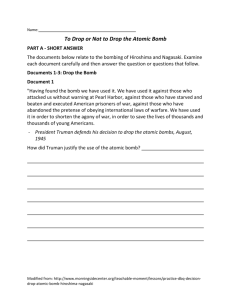Did the United States Have to Drop Atomic Bombs on Hiroshima and
advertisement
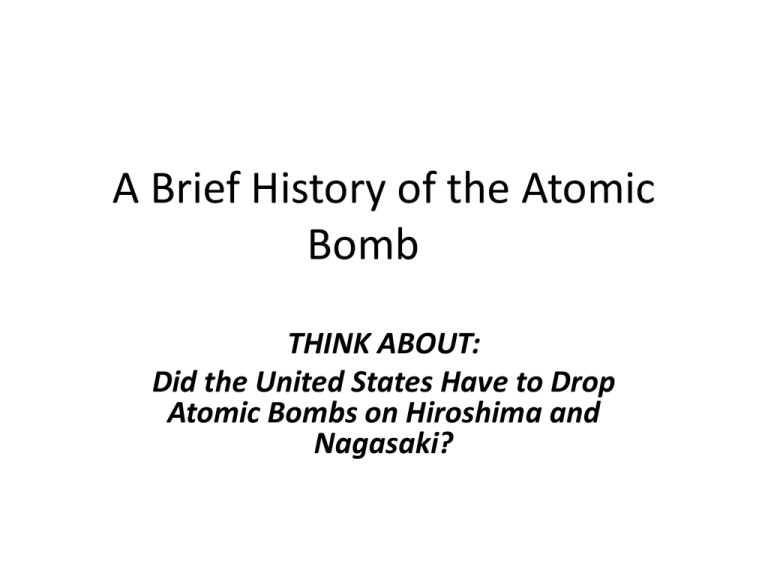
A Brief History of the Atomic Bomb THINK ABOUT: Did the United States Have to Drop Atomic Bombs on Hiroshima and Nagasaki? Albert Einstein’s Letter to FDR • August 1939- FDR receives letter signed by Einstein; brilliant, well-respected physicist • Einstein alerts FDR that Nazi Germany may be building an atomic weapon • US not yet at war with Germany • Einstein says US is now able to set up a nuclear chain reaction using uranium. • This reaction would unleash massive amounts of power and radiation- creating the world’s most powerful weapon. • Several famous scientists disagree with Einstein’s ideas • FDR very interested- starts atomic weapon project in Oct. 1941 What should FDR do? Manhattan Project • Manhattan Project- code name for secret US program to develop atomic bomb • Robert Oppenheimer lead scientist on Manhattan Project • Cost over $2 Billion ($25 B today) • July 16, 1945- first test of atomic bomb at Alamogordo, NM • Test detonation left a crater of radioactive glass 250 m wide, blast felt 100 miles away, mushroom cloud rose over 7 miles ___________________________________________________ Where did the scientists get the Uranium and Plutonium needed for atomic bombs? How did the “bomb” work? Spies? Hiroshima • First bomb, called “Little Boy”, dropped over Hiroshima on Aug. 6, 1945 • Enola Gay is name of B-29 bomber used for mission • Center of explosion reaches 500,000 degrees • Used uranium gun-trigger device • 80,000-90,000 killed instantly • Japanese refuse to surrender! Nagasaki • Second bomb, called “Fat Man”, dropped over Nagasaki on Aug 8, 1945 • Used plutonium-core implosion device • 70,000 killed instantly • Japanese now agree to unconditional surrender Did President Harry S. Truman make the right decision in dropping atomic bombs on Japan? The US needed to drop atomic weapons on Japan because: • The Japanese had demonstrated near-fanatical resistance, fighting to almost the last man on Pacific islands, committing mass suicide on Saipan and kamikaze attacks at Okinawa. Fire-bombing had killed 100,000 in Tokyo with no political effect. Only the atomic bomb could force Japan's leadership to surrender. • With only two bombs ready (and a third on the way by late August 1945) it was too risky to "waste" one in a demonstration over an unpopulated area. • An invasion of Japan would have caused casualties on both sides that could easily have exceeded the number of deaths at Hiroshima and Nagasaki. • The two targeted cities would have been firebombed anyway. • Immediate use of the bomb convinced the world of its horror and prevented future use. • The bomb's use impressed the Soviet Union and halted the war quickly enough that the USSR did not demand joint occupation of Japan. The US did not need to drop atomic weapons on Japan because: • Japan was ready surrender. More than 60 of its cities had been destroyed by conventional bombing and firebombing, the home islands were being blockaded by the US Navy, and the Soviet Union entered the war by attacking Japanese troops in Manchuria. • A demonstration explosion over Tokyo harbor would have convinced Japan's leaders to surrender. • The bomb was dropped to justify the $2 billion spent on its development. • Hiroshima and Nagasaki were of limited military value. Civilians outnumbered troops in both cities around six to one. • Japanese lives were sacrificed simply to “scare” the Soviet Union.
